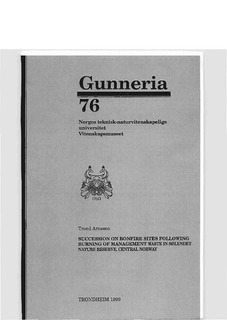Succession on bonfire sites following burning of management waste in Sølendet Nature Reserve, central Norway
Research report
Permanent lenke
http://hdl.handle.net/11250/273028Utgivelsesdato
1999Metadata
Vis full innførselSamlinger
- Institutt for naturhistorie [1225]
Sammendrag
In Splendet Nature Reserve in the boreal uplands of central Norway, burning of brash and herbage from clearing and mowing has taken place on 118 bonfire sites since 1978, as part of the management and restoration of outlying haymaking land. In 1982-1997, the revegetation of 36 sites in fen margin, grassland and heathland was investigated using 96 permanent plots. Measurements of pH and mineral content in soil and ash indicated a harsh chemical environment after burning, but conditions ameliorated over time due to leaching. Although the severe conditions seen during the first year after burning seemed to hamper the establishment of new vegetation, the plots were usually covered by early-successional bryophytes within 2-4 years. Bryum spp., Ceratodon purpureus, Funaria hygrometrica, Leptobryum pyriforme, Polytrichum juniperinum and Marchantia spp. were common dominant bryophytes during the early stages of this secondary succession. Recovery of the field layer was a slower process. Anemochorous shrubs (e.g. Betula pubescens and Salix spp.), the tall graminoid Deschampsia cespitosa and rhizomateous species (e.g. Equisetum palustre, Agrostis capillaris and Eriophorum angustifolium) became established early. Although an increase in the occurrence and abundance of common fen and grassland species was recorded, several dominant, early-successional bryophytes and vasculars were stable for many years and seemed to inhibit the expansion of other species.
